Table of Contents
CBSE Previous Year Question Papers Class 12 Chemistry 2017 Delhi
Time allowed: 3 hours
Maximum Marks: 70
General Instructions
- All questions are compulsory.
- Section A: Questions number 1 to 5 are very short answer questions and carry 1 mark each.
- Section B: Questions number 6 to 12 are short answer questions and carry 2 marks each.
- Section C: Questions number 13 to 24 are also short answer questions and carry 3 marks each.
- Section D: Questions number 25 to 27 are long answer questions and carry 5 marks each.
- There is no overall choice. However, an internal choice has been provided in two questions of one mark, two questions of two marks, four questions of three marks and all the three questions of five marks weightage. You have to attempt only one of the choices in such questions
- Use of log tables, if necessary. Use of calculators is not allowed.
CBSE Previous Year Question Papers Class 12 Chemistry 2017 Delhi Set I
Section – A
Question 1.
Write the formula of an oxo-anion of Manganese (Mn) in which it shows the oxidation state equal to its group number. [1]
Answer:
Manganese belongs to group number 7 and its oxidation state in KMnO4 is +7
i.e., KMnO4
1 + x + 4 (-2) = 0
⇒ 1 + x – 8 = 0
⇒ x = 7
Thus, the formula of the oxo-anion is KMnO4.
Question 2.
Write IUPAC name of the following compound: [1]
(CH3CH2)2NCH3
Answer:
N-Ethyl-N-methylhexanamine.
Question 3.
For a reaction R → P, half-life (t1/2) is observed to be independent of the initial concentration of reactants. What is the order of reaction? [1]
Answer:
Since half-life is independent of the initial concentration of the reactants. Thus it is a first-order Reaction. The formula for the half-life of the first-order reaction.
t1/2 = \(\frac { 0.693 }{ K }\)
Question 4.
Write the structure of l-Bromo-4-chlorobut-2- ene. [1]
Answer:
BrCH2CH = CHCH2Cl
Question 5.
Write one similarity between physisorption and Chemisorption. [1]
Answer:
Physisorption and chemisorption both are the surface phenomenon and both increases the surface area during the process of adsorption.
Section – B
Question 6.
Complete the following reactions:
(i) NH3 + 3Cl2(excess) →
(ii) XeF6 + 2H2O →
OR
What happens when
(i) (NH4)2Cr2O7 is heated?
(ii) H3PO3 is heated?
Write the equations. [2]
Answer:
(i) NH3 + 3Cl2 (excess) → NCl3 + 3HCl.
(ii) XeF6 + 2H2O → XeO2F2 + 4HF
OR
(i) (NH4)2Cr2O7(s) → Cr2O3(s) + N2(g) + 4H2O(g)
(ii) 4H3PO3 → 3H3PO4 + PH3.
Question 7.
Define the following terms:
(i) Colligative properties
(ii) Molality (m) [2]
Answer:
(i) Colligative properties are those which depends on a number of moles of solute irrespective of their Nature.
(ii) Molality is defined as the number of moles of solute dissolved per kg of the solvent. It is independent of temperature.

Question 8.
Draw the structures of the following:
(i) H2S2O7
(ii) XeF6
Answer:
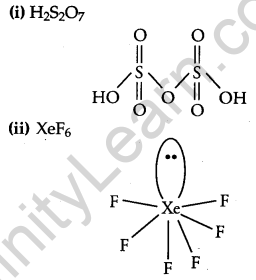
Question 9.
Calculate the degree of dissociation (α) of acetic acid if it’s molar conductivity (∧m) is 39.05 S cm2 mol-1.
Given: ∧0 (H+) = 349.6 S cm2 mol-1 and ∧0 (CH3COO–)= 40.9 S cm2 mol-1. [2]
Answer:
Given: Molar conductivity (∧m) for acetic acid = 39.05 S cm2 mol-1.
∧0 (H+) = 349.6 S cm2 mol-1
∧0 (CH3COO–) = 40.95 S cm2 mol-1
We know that:
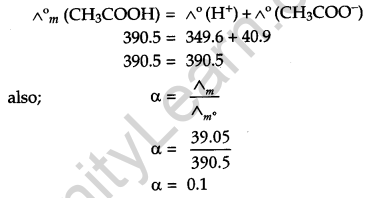
Thus, the degree of dissociation of acetic acid is 0.1.
Question 10.
Write the equations involved in the following reactions:
(i) Wolff-Kishner reduction
(ii) Etard reaction. [2]
Answer:
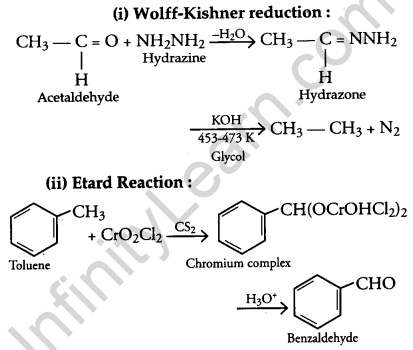
Section – C
Question 11.
A 10% solution (by mass) of sucrose in water has a freezing point of 269.15 K. Calculate the freezing point of 10% glucose in water if the freezing point of pure water is 273.15K.
[Given: (Molar mass of sucrose = 342 g mol-1), (Molar mass of glucose = 180 g mol-1)] [3]
Answer:
Given: Freezing point of = 269.15 K 10% solution of glucose
The freezing point of pure water = 273.15 K
The molar mass of sucrose = 342 g mol-1.
The molar mass of glucose = 180 g mol-1.
We know that:
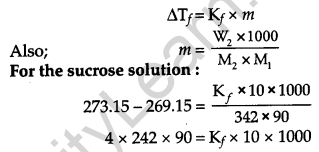
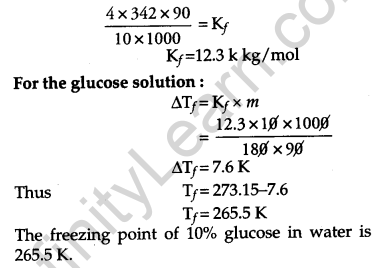
Question 12.
(a) Calculate the mass of Ag deposited at cathode when a current of 2 amperes was passed through a solution of AgNO3 for 15 minutes.
Given: Molar mass of Ag = 108 g mol-1, 1F = 96500 C mol-1)
(b) Define fuel cell [3]
Answer:
(a) Given:
Current = 2 amperes
Time = 15 minutes
Molar mass of Ag = 108 g mol-1
1F = 96500 C mol-1
Amount of metal deposited (m) = ZQ
Q = It = 2 × 15 × 60 = 1800 C
Silver deposited Ag+ + 2e– → Ag(s)
1 mole of electron or 1 × 96500 C of current deposit silver = 108 g
1800 C of current will deposit = \(\frac { 108\times 1800 }{ 96500 }\)
Amount of Ag deposited = 2.01g
(b) Fuel cell is the cell which converts the energy of combustion of fuels directly into electrical energy.
Question 13.
(i) What type of isomerism is shown by the complex [Co(NH3)6]Cr(CN)6]?
(ii) Why a solution of [Ni(H2O)6]2+ is green while a solution of [Ni(CN)4]2- is colourless? (At no. of Ni = 28)
(iii) Write the IUPAC name of the following complex: [3]
[CO(NH3)5(CO3)]Cl.
Answer :
(i) Both shows coordination isomerism because both cationic and anionic entities and isomers differ in the distribution of ligands in the coordination entity of cationic and anionic part.
(ii) In [Ni(H2O)6]2+ Ni is in +2 oxidation state with electronic configuration 3d8. In the presence of weak ligand H2O the two unpaired electrons do not pair up and hence the complex has two impaired electrons. Therefore, it is coloured and shows d-d transitions which absorb red light and emits green complimentary light.
In case of [Ni(CN)4]2- Ni also shows +2 oxidation state but CN ligand is strong ligand and two unpaired electrons undergo pairing, to no d-d transitions takes place and it shows no colour.
(iii) Pentaamminecarbonatocobalt(III) chloride.
Question 14.
Write one difference in each of the following:
(i) Lyophobic sol and Lyophilic sol.
(ii) Solution and Colloid
(iii) Homogeneous catalysis and Heterogeneous catalysis. [3]
Answer:
(i) Lyophobic colloidal sols are not hydrated and have a weak affinity with the dispersion medium whereas lyophilic colloidal sols are heavily hydrated and have a strong affinity with the dispersion medium.
(ii) The solution is a homogeneous mixture of solute and solvent whereas colloid is the heterogeneous mixture of the dispersed phase and the dispersion medium.
(iii) Homogeneous catalysis is the catalysis in which the reactants and the catalysts are in the same phase whereas in the heterogeneous catalysis the reactants and the catalysts are in the different phases.
Question 15.
Following data are obtained for reaction:
N2O5 → 2NO2 + \(\frac { 1 }{ 2 }\) O2

(a) Show that it follows first order reaction.
(b) Calculate the half-life.
(Given log 2 = 0.3010, log 4 = 0.6021) [3]
Answer:
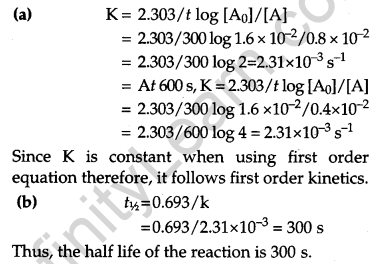
Question 16.
Following compounds are given to you:
2-Bromopentane, 2-Bromo-2-methyl butane, 1-Bromopentane
- Write the compound which is most reactive towards SN2 reaction.
- Write the compound which is optically active.
- Write the compound which is most reactive towards β-elimination reaction. [3]
Answer:
- 1-Bromopentane is most reactive towards SN2 reaction as it follows the order 1° > 2° > 3°.
- 2-Bromopentane is optically active.
- 2-Bromo-2-methyl butane is most reactive towards β-elimination reaction.
Question 17.
- Write the principle of the method used for the refining of germanium.
- Out of PbS and PbCO3 (ores of lead), which one is concentrated by froth floatation process preferably?
- What is the significance of leaching in the extraction of aluminium? [3]
Answer:
- Zone refining method is used for the refining of germanium and it is based on the principle that the impurities are more soluble in the melt than in the solid-state of the metal.
- PbS, Sulphide ore has more tendency to stick to the oil which comes on the surface being lighter and easily skimmed off so PbS is concentrated by froth floatation method.
- Leaching of alumina is done to remove the impurities like SiO2 by using NaOH solution and pure alumina is obtained.
Question 18.
Write structures of compounds A, B and C in each of the following reactions: [3]

OR
Do the following conversions in not more than two steps:
(a) Benzoic acid to Benzaldehyde
(b) Ethylbenzene to Benzoic acid
(c) Propanone to Propene
Answer:
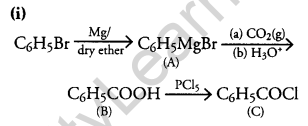
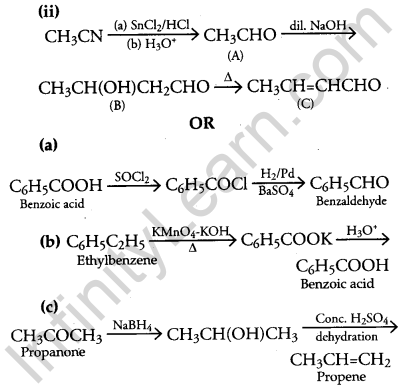
Question 19.
Write the structure of the monomers used for getting the following polymers:
(i) Dacron [3]
Answer:
(i) Monomers of Dacron:

Question 21.
Give reasons:
(i) Thermal stability decreases from H2O to H2Te.
(ii) Fluoride ion has higher hydration enthalpy than chloride ion.
(iii) Nitrogen does not form pentahalide. [3]
Answer:
(i) As we move down in a group atomic radius increases as a result bond length increases. Larger the bond length lesser will be the bond dissociation enthalpy. So thermal stability decreases from O to Te.
(ii) Fluoride ion is the smallest ion in the group and it has high charge density and charges size ratio. That is why it has a high hydration enthalpy.
Section – E
Question 24.
(a) Account for the following:
(i) Transition metals form a large number of complex compounds.
(ii) The lowest oxide of transition metal is basic whereas the highest oxide is amphoteric or acidic.
(iii) E0 value for the Mn3+/Mn2+ couple is highly positive (+1.57 V) as compare to Cr3+/Cr2+.
(b) Write one similarity and one difference between the chemistry of lanthanoid and actinoid elements. [5]
OR
(a) (i) How is the variability in oxidation states of transition metals different from that of the p-block elements?
(ii) Out of Cu+ and Cu2+, which ion is unstable in aqueous solution and why?
(iii) The orange colour of Cr2O72- ion changes to yellow when treated with an alkali. Why?
(b) Chemistry of actinoids is complicated as compared to lanthanoids. Give two reasons.
Answer:
(i) Transition metals form a large number of complexes due to:
- The small size of atoms and ions of transition metals.
- High nuclear charge.
- Presence of incompletely filled d-orbitals.
(ii) As the oxidation state increases the size of ion goes on decreasing thus the covalent character increases as a result of this amphoteric and acidic strength increases. While in case of lower oxides of transition metals ionic size increases and thus basic character increases.
(iii) Because Mn2+ has 3d5 as a stable oxidation state which is half-filled and stable. Mn has very high third ionization energy for change from d5 to d4 but in case of Cr3+, 3d3 is more stable due to completely half-filled t2g orbitals (crystal field spitting theory) and that is why Mn3+ /Mn2+ is highly positive as compared to Cr3+ /Cr2+.
(b) Both Lanthanoids and Actinoids have the t3 oxidation state and both show contraction or irregular electronic configuration while the major difference between the lanthanoids and actinoids is actinoids are radioactive while lanthanoids are not radioactive in nature.
OR
(a) (i) In p block elements the difference in oxidation state is 2 and in transition elements, the difference is 1.
(ii) Cu+ is unstable in aq. solution because it undergoes disproportion reaction and has low hydration enthalpy.
(iii) In alkaline medium dichromate ions Cr2O72- changes to chromate ion CrO42-, which is yellow in colour due to which the colour changes when treated with an alkali.
(b) Chemistry of actinoids is complicated as compared to lanthanoids due to the following reasons:
- They show multiple oxidation states namely +5, +6 and +7 oxidation states respectively which permits the formation of higher oxidation states through the removal of the periphery electrons.
- They are radioactive and have a strong propensity to form complex reactions because of its unstable isotopes, some actinoids are formed naturally by radioactive decay.
Question 25.
(a) An element has atomic mass 93 g mol-1 and density 11.5 g cm-3. If the edge length of its unit cell is 300 pm, identify the type of unit cell.
(b) Write any two differences between amorphous solids and crystalline solids. [5]
OR
(a) Calculate the number of unit cells in 8.1 g of aluminium if it crystallizes in an f.c.c. structure.
(Atomic mass of Al = 27 g mol-1)
(b) Give reasons:
- In stoichiometric defects, NaCl exhibits Schottky defect and not Frenkel defect.
- Silicon on doping with phosphorous forms n-type semiconductor.
- Ferrimagnetic substances show better magnetism than antiferromagnetic substances.
Question 26.
(a) Write the product(s) in the following reactions:
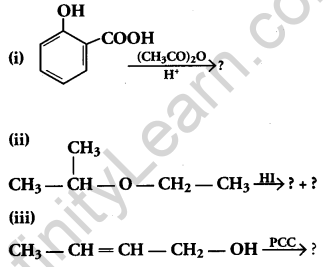
(b) Give simple chemical tests to distinguish between the following pairs of compounds:
(i) Ethanol and Phenol
(ii) Propanol and 2-methyl propane-2-ol [5]
OR
(a) Write the formula of reagents used in the following reactions:
(i) Bromination of phenol to 2, 4, 6-tribromophenol
(ii) Hydroboration of propene and then oxidation to propanol.
(b) Arrange the following compound groups in the increasing order of their property indicated:
(i) p-nitrophenol, ethanol, phenol (acidic character)
(ii) Propanol, propane, Propanal (boiling point)
(c) Write the mechanism (using curved arrow notation) of the following reaction:

Answer:
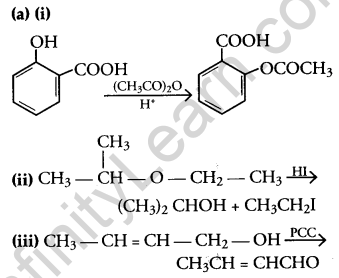
(b) (i) Ethanol and phenol: When neutral ferric chloride is added to both the compounds phenol gives violet coloured complex whereas ethanol does not give this complex when treated with ferric chloride solution.
(ii) Propanol and 2-methyl propane-2-ol: When both the solutions were treated with anhydrous ZnCl2 and conc. HCl (Luca’s test) the 2-methyl propane-2-ol gives the turbidity immediately whereas propanol does not give the turbidity immediately.
OR
(a) (i) Aq-Br2
(ii) B2H6 and then H2O2 and OH-
(b) (i) Ethanol < Phenol < p-Nitrophenol.
(ii) Propane < Propanal < Propanol
![]()

CBSE Previous Year Question Papers Class 12 Chemistry 2017 Delhi Set II
Note: Except for the following questions, all the remaining questions have been asked in previous sets.
Section – A
Question 1.
Write the structure of 2, 4-dinitrochlorobenzene. [1]
Answer:
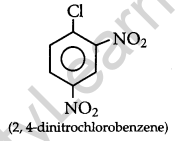
Question 4.
Write IUPAC name of the following compound:
CH3NHCH(CH3)2 [1]
Answer:
N-methyl propane-2-amine.
Question 5.
Write the formula of an oxo-anion of chromium (Cr) in which it shows the oxidation state equal to its group number. [1]
Answer:
Chromium belongs to group number 6 and its oxidation state in K2Cr2O7 is +6
i.e., K2Cr2O7
1 × 2 + 2x + (-2 × 7) = 0
⇒ 2 + 2x – 14 = 0
⇒ 2x – 12 = 0
⇒ 2x = 12
⇒ x = 6
Thus, the formula of the oxo-anion is K2Cr2O7
Section – B
Question 7.
Draw the structures of the following: H3PO2 [2]
Answer:

Question 8.
Define the following terms:
(i) Ideal solution
(ii) Molarity (M) [2]
Answer:
(i) Ideal solutions are those solutions that obey Raoult’s law over the entire range of concentration.
Example: Benzene and toluene, n-heptane and n-hexane.
(ii) Molarity is defined as the number of moles of solute dissolved per liter of solution.
\(M=\frac { { W }_{ b }\times 1000 }{ { M }_{ b }\times V }\)
Question 9.
Complete the following reactions: [2]
(i) Cl2 + H2O →
(ii) XeF6 + 3H2O →
OR
What happens when
(i) conc. H2SO4 is added to Cu?
(ii) SO3 is passed through water?
Write the equations.
Answer:
(i) Cl2 + H2O → 2HCl + [O]
(ii) XeF6 + 3H2O → XeO3 + 6HF
OR
(i) Cu + 2H2SO4 → CuSO4 + SO2 + 2H2O
(ii) SO3 + H2O → H2SO4
Question 10.
Write the reactions involved in the following:
(i) Hell-Volhard-Zelinsky reaction
(ii) Decarboxylation reaction [2]
Answer:
(i) Hell-Volhard Zelinsky reaction:
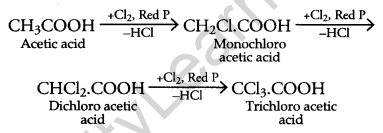
(ii) Decarboxylation reaction:

Section – C
Question 13.
Write the principles of the following methods:
(i) Vapour phase refining [3]
Answer:
(i) Vapour phase refining: It is based on the principle that the metal is converted into its volatile compound and collected elsewhere. It is then decomposed to give pure metal.
Question 15.
Define the following:
(iii) Disinfectants [3]
Answer:
(iii) Disinfectants: These are the substances that are applied to non-living objects to destroy microorganisms that are present on the objects.
Example: 1-2% Phenol solution.
CBSE Previous Year Question Papers Class 12 Chemistry 2017 Delhi Set III
Note: Except for the following questions, all the remaining questions have been asked in previous sets.
Section – A
Question 4.
Write the structure of 3-Bromo-2-methylprop-1-ene. [1]
Answer:
BrCH2(CH3)C = CH2
Question 5.
Write IUPAC name of the following compound:
(CH3)2N-CH2CH3) [1]
Answer:
N, N-dimethylethanolamine
Section – B
Question 6.
Write the reactions involved in the following reactions:
(i) Clemmensen reduction
(ii) Cannizzaro reaction [2]
Answer:
(i) Clemmensen reduction:
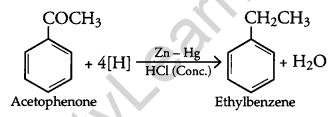
(ii) Cannizzaro reaction:

Question 7.
Draw the structures of the following:
(i) H4P2O7
(ii) XeOF4
Answer:
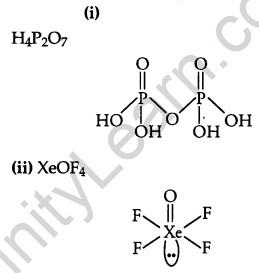
Question 8.
Define the following terms:
(ii) van’t Hoff factor (i) [2]
Answer:
(ii) van’t Hoff factor(i): It is defined as the extent of dissociation or association or the ratio of the observed colligative property to the calculated colligative property.
Question 10.
Complete the following chemical equations: [2]
(i) F2 + 2Cl– →
(ii) 2XeF2 + 2H2O →
OR
What happens when
(i) HQ is added to MnO2?
(ii) PCl5 is heated?
write the equations involved.
Answer:
(i) F2 + 2Cl– → 2F– + Cl2
(ii) 2XeF2 + 2H2O → 2Xe + 4HF + O2
OR
(i) MnO2 + 4HCl → MnCl2 + Cl2 + 2H2O
(ii) PCl5 → PCl3 + Cl2
Section – C
Question 14.
Write the structures of the monomers used for getting the following polymers:
(i) Nylon-6
Answer:
(i) Monomers of Nylon-6:
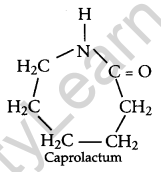
Question 19.
Write one difference between each of the following:
(i) Multimolecular colloid and Macromolecular colloid
(ii) Sol and Gel
(iii) O/W emulsion and W/O emulsion [3]
Answer:
(i) In multimolecular colloids, a large number of atoms or smaller molecules of a substance aggregates together to form species having a size in the colloidal range.
Example: Sulphur sol whereas in macro-molecular colloids the colloidal particles are large molecules having colloidal dimensions.
Example: Starch.
(ii) In sol the dispersing phase is solid and dispersing medium is liquid;
Example: paint, gold sol etc., whereas in Gel the dispersing phase is liquid and dispersing medium is solid;
Example: Jelly, butter etc.
(iii) In O/W emulsion, oil is the dispersed phase while water is the dispersion medium
Example: milk, vanishing cream etc whereas in W/O emulsion water is the dispersed phase while oil is the dispersion medium.
Example: Cold cream, butter etc.
Question 20.
(i) What type of isomerism is shown by the complex [Co(en)3]Cl3?
(ii) Write the hybridisation and magnetic character of [Co(C2O4)3]3- (At. no. of Co = 27)
(iii) Write IUP AC name of the following Complex [Cr(NH3)3Cl3]. [3]
Answer:
(i) Since the given coordinate compound does not have a plane of symmetry and the ligand attached is bidentate ligand so it will show optical isomerism.
(ii) [Co(C2O4)3]3- Co is in +3 oxidation state with an electronic configuration of 3d6 Oxalate is a strong field ligand so the pairing of electrons takes place.

(iii) Triamminetrichloridochromium(III).



